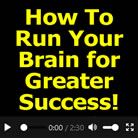Yes—It’s Possible
(An excerpt from Dr. Larry’s eBook “Growing Confidence & Esteem”)
Is there any area of your life where being confident, poised and feeling good about yourself would not be of benefit?
You can begin building an unshakeable belief in yourself. Daily you can generate the beliefs and attitudes crucial to the mind set of success.
A Defeated Self-Image
Born in 1606, the 9th child of a moderately well to do family this boy suffered from severe self-doubt and lack of confidence. He was known to have long bouts of depression during which he would sit alone in a shared bedroom.
School for him was a trial. Though he worked hard at his subjects, Latin, which was considered the most essential skill to any well bred Dutchman, eluded him. The more he struggled with Latin the worse he felt about himself. In the competitive school he attended most of his fellow classmates had little to do with him because he was not considered bright enough.
To occupy his time when he should have been working on his studies, he often doodled. As he got closer to his teen years his lack of confidence and low self-esteem worsened and his bouts of depression lengthened. This downward spiral resulted from listening to the negativity of what others said about him, desperately worrying his parents.
His one activity that was semi-good, was that he would draw caricatures of people and rough sketches of his environment. His mother and father discussed repeatedly that scholarship was never going to be his strength and that with luck he would find some career to support himself.
Growth of Skill and Passion
For years they had watched him sketch, and wondered if perhaps he could find a way to grow his skill in art. So at age 15, he was apprenticed to a history book artist. From the one-on-one mentoring he received, his skill and technique rapidly evolved, and his confidence and belief in himself began to expand.
By age 19 he began to do privately commissioned artworks and personal portraits for the wealthy. At this time he also opened his own studio and began to privately tutor a handful of other artists.
By age 22 he was beginning to be known as a master of portrait painting. At that time he painted the portrait of the Dutch Prince Frederick Hendrick. From this work, he became famous throughout Europe as a result of his amazing portraiture for the Prince and for other members of the Court of Haig.
Until he died in 1669, Rembrandt van Rijn was highly regarded for his numerous contributions to painting, etching and the teaching of hundreds of artists—many of whom went on to become famous themselves.
In a letter he wrote to one of his brothers, Rembrandt said that his art didn’t really begin to be exceptional until he began feeling good about himself as a person. That as he liked himself better, it opened his creativity. It lifted his spirits and allowed him to begin truly delving deep into his own talents.
As he felt better about himself his skill blossomed overcoming those limiting beliefs that gave him low self-esteem and lack of self-confidence. It opened him to his potential and helped him enjoy his life and furthered his growing skill.
The Ways Emotions Are Created
Why does low self-esteem or low self-confidence happen? There are many reasons but the primary cause is our own negative thinking and negative self-talk patterns.
Medicine and psychology have found there are only four primary ways that emotions are created.
One way is chemical or hormonal change in the body. Everything you put in your body is a chemical, isn’t it? Coffee, tea, sugar, water, alcohol, drugs, food, vitamins – everything you put into you is a chemical. Our hormones change, we have 30 plus hormones that regulate everything in your body, they fluctuate up and down. So, chemical or hormonal change in the body is one way.
The second way is damage to the brain or central nervous system. I guarantee that if you stand back 20 or 30 feet from a brick wall and run into it head first, it’s going to change how you feel—quickly. Damage to the brain is another way emotions are created. An example would be having a stroke, an aneurism, bruising the brain, hitting your head into the windshield of a car. Those things can cause emotions to rise and fall.
The third way emotions are created is because of your self-talk and the images in your mind. It’s the chatter in your head that never let’s up, and the mental images that float through
The fourth way is because of something happening to your physiology. You’re too hot, you’re too cold, you get injured, you’re ill, something happens to you physically and it causes an emotional disruption.
Of these 4 ways that emotions are created, #3 your self-talk and the pictures in your mind, create between 65-75% of all your emotions! So it’s crucial that you begin to watch and to catch and change that negative self-talk in your mind.
You may never be the painter that Rembrandt was, but the process of changing your internal dialogue to one that builds you up, instead of tearing you down, can be done.
Choose to focus on the positive. You and everyone around you will benefit.
The Best of Success to You,
Dr. Larry
Posted: November 24th, 2010 under Books.






